The ram1 mutant of Arabidopsis exhibits severely decreased beta-amylase activity
- PMID: 11743123
- PMCID: PMC133583
The ram1 mutant of Arabidopsis exhibits severely decreased beta-amylase activity
Abstract
Despite extensive biochemical analyses, the biological function(s) of plant beta-amylases remains unclear. The fact that beta-amylases degrade starch in vitro suggests that they may play a role in starch metabolism in vivo. beta-Amylases have also been suggested to prevent the accumulation of highly polymerized polysaccharides that might otherwise impede flux through phloem sieve pores. The identification and characterization of a mutant of Arabidopsis var. Columbia with greatly reduced levels of beta-amylase activity is reported here. The reduced beta-amylase 1 (ram1) mutation lies in the gene encoding the major form of beta-amylase in Arabidopsis. Although the Arabidopsis genome contains nine known or putative beta-amylase genes, the fact that the ram1 mutation results in almost complete loss of beta-amylase activity in rosette leaves and inflorescences (stems) indicates that the gene affected by the ram1 mutation is responsible for most of the beta-amylase activity present in these tissues. The leaves of ram1 plants accumulate wild-type levels of starch, soluble sugars, anthocyanin, and chlorophyll. Plants carrying the ram1 mutation also exhibit wild-type rates of phloem exudation and of overall growth. These results suggest that little to no beta-amylase activity is required to maintain normal starch levels, rates of phloem exudation, and overall plant growth.
Figures
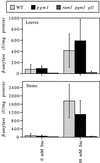
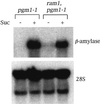
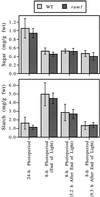
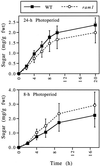
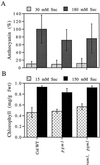
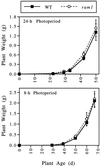
References
-
- Beck E, Ziegler P. Biosynthesis and degradation of starch in higher plants. Annu Rev Plant Physiol Plant Mol Biol. 1989;40:95–117.
-
- Brown JWS. Arabidopsis intron mutations and pre-mRNA splicing. Plant J. 1996;10:771–780. - PubMed
-
- Brown JWS, Smith P, Simpson CG. Arabidopsis consensus intron sequences. Plant Mol Biol. 1996;32:531–535. - PubMed
Publication types
MeSH terms
Substances
LinkOut - more resources
Full Text Sources
Other Literature Sources
Molecular Biology Databases
